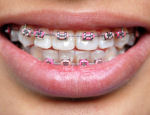
Types of Orthodontic Appliances
Orthodontists use a combination of different treatment approaches such as the use of orthodontic appliances, teeth removal, or jaw surgery to fix the way teeth and jaws are aligned.
Different types of orthodontic appliances may be used for different purposes in the course of an orthodontic treatment. Some, such as dental braces, are designed to primarily move teeth in three dimensions (orthodontic), while others are used to correct problems related with facial growth (orthopedic).
There are two general types of orthodontic devices, based on if they can be removed by the patient or not.
Fixed orthodontic appliances
- Dental braces – are the most common type of fixed orthodontic appliances. They are sets of brackets cemented to the front of each tooth, and stainless steel wires threaded through them. The gentle and consistent pressure of orthodontic braces slowly moves and correctly repositions the teeth. The braces need to be periodically adjusted by the orthodontist. Dental braces can be made of metal (stainless steel, gold, silver), ceramic or plastic material.
- Fixed functional appliances - are usually fixed to the upper and lower molar teeth and may not be removed by the patient. Functional appliances are used to normalize growth discrepancies between the upper and lower jaw. They use the muscle action from speaking, eating and swallowing to create forces that move teeth and align the jaws to correct protrusion problems.
- Palatal expanders - are also fixed orthodontic appliances. Palatal expanders are fixed to the upper back teeth in order to make the upper jaw wider. The use of palate expanders in patients with a smaller jaw may decrease the need for extraction of one or more permanent teeth to prevent teeth crowding.
Removable orthodontic appliances
- Headgear is a type of orthodontic appliance that puts pressure to the upper teeth and upper jaw to guide the direction of upper jaw growth and tooth eruption. Rubber bands are hooked to the braces and connected to a strap worn around the head. The headgear may be removed by the patient and is usually worn 10 to 12 hours per day.
- Retainers are removable orthodontic appliances made of molded plastic and wire. They hold the teeth in their correct positions after orthodontic treatment has finished and braces are removed. A retainer is usually worn for at least six months upto several years after orthodontic treatment.
 The orthodontist decides to use either fixed or removable appliances based on an individual patient’s treatment needs and self-compliance.
Removable orthodontic appliances are effective only if they are worn for several hours a day according to orthodontist’s directions.
If the orthodontist is hesitant about the patient’s compliance, fixed type orthodontic appliances may be preferred if possible.
The orthodontist decides to use either fixed or removable appliances based on an individual patient’s treatment needs and self-compliance.
Removable orthodontic appliances are effective only if they are worn for several hours a day according to orthodontist’s directions.
If the orthodontist is hesitant about the patient’s compliance, fixed type orthodontic appliances may be preferred if possible.
![]() The cost of orthodontic treatment can be significant and many patients may not afford it if they are not covered by their dental insurance.
Learn how to choose a dental insurance plan that will provide the best dental treatment to you and your family.
The cost of orthodontic treatment can be significant and many patients may not afford it if they are not covered by their dental insurance.
Learn how to choose a dental insurance plan that will provide the best dental treatment to you and your family.

